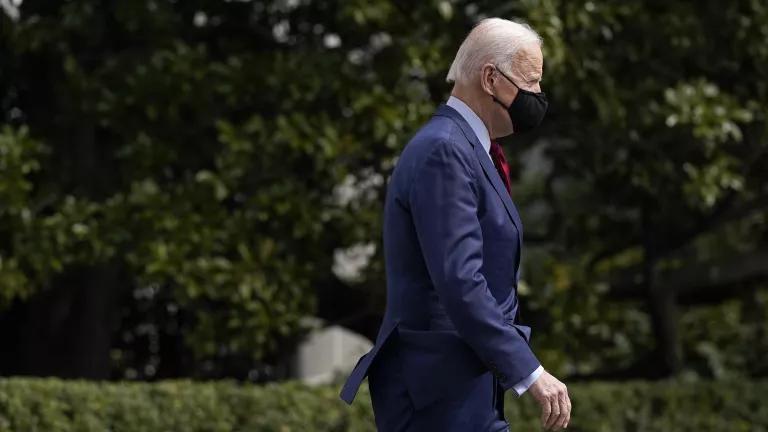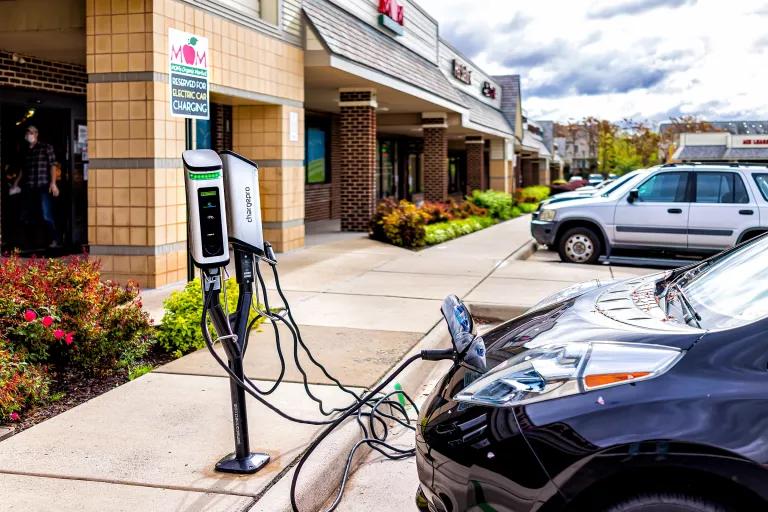Biden Pledges to Cut U.S. Carbon Emissions in Half by 2030
It’s urgent. It’s ambitious. But most of all, it’s totally doable.

To kick off a virtual, White House–hosted Earth Day summit at which world leaders will spend the next two days discussing strategies for dramatically reducing their respective countries’ greenhouse gas emissions, President Biden unveiled his own proposal for doing so. Alongside Biden’s decision to rejoin the Paris climate agreement, the moment marks the long-awaited reemergence of the United States as a serious presence on the international climate stage—after four years of the Trump administration’s reckless inaction.
Earlier this morning, President Biden announced that the United States is formally committing to cutting its carbon pollution by between 50–52 percent from 2005 levels by the year 2030. The goal is certainly ambitious—nearly double President Obama’s commitment back in 2015—but such ambition is called for. By putting the new emissions target in the context of his sweeping $2.7 trillion American Jobs Plan, Biden is driving home the connection between climate and his larger, holistic vision for rebuilding and strengthening a country that’s currently facing severe and intertwining challenges. If we’re really going to build back better, we can’t afford to consider public health, the economy, equity, racial justice, infrastructure, and climate in isolation. Just as these national issues are inextricably linked, so, too, must be the national response to them.
“This is a moral imperative, an economic imperative, a moment of peril—but also a moment of extraordinary possibilities," Biden said at today's virtual climate change summit with 40 world leaders. "Time is short, but I believe we can do this.”
At the heart of both the climate summit and the new carbon pollution target is a basic fact: To avoid experiencing the worst impacts of climate change, the nations of the world must stop average global temperatures from rising more than 1.5 degrees Celsius (2.7 degrees Fahrenheit) compared to pre-industrial levels. To help meet this shared goal, the United States will need to adopt a “whole-of-government” approach that calls upon all federal agencies and departments to make emissions cuts a top priority for their operations as well as the policies they craft.
Biden’s commitment reflects the urgency of the climate crisis but also something else: an acceptance that technology, public sentiment, and political reality have finally converged to make that goal more feasible than ever. According to a recent analysis conducted by NRDC, the Biden administration’s new target is absolutely achievable, thanks to developments in clean energy, energy efficiency, and electrification. In fact, the modeling shows that the United States could cut greenhouse gas emissions by 53 percent by 2030—and all at a cost of less than one-half of a percentage point of the nation’s projected gross domestic product.

The strategies outlined below would not only help combat the global climate crisis by inspiring global action, but they would also greatly benefit the country and its people in numerous ways. Millions of new jobs would be created in the growing fields and industries related to the implementation of clean power and energy efficiency. These could be everything from installing solar panels or servicing windmill turbines to weatherizing homes and apartment buildings. Tens of thousands of premature deaths linked to air pollution could also be avoided each year. In less than a decade, we could start reaping the benefits of the policies we put in place today: revived local economies, a healthier and more just nation, and a liveable future for the generations who follow us. Here are some of the ways we can get there.
More clean energy: First, NRDC’s analysts calculate that as much as 80 percent of electricity could come from zero-carbon sources—especially wind and solar—within the next nine years. By then, the last coal-fired power plants in the country will have likely gone offline, and the percentage of electricity that we generate from natural gas will have dropped by half, to 20 percent from the current 40 percent. To help these things come to pass, the Biden administration can offer tax incentives for states, cities, and businesses to choose cleaner energy sources and provide federal funding for the construction and modernization of electricity transmission infrastructure. Biden’s EPA could also beef up the carbon standards for power plants, which would have the added benefit of keeping other harmful emissions (such as nitrous oxides and sulfur dioxide) out of the air. Together, these clean energy strategies won’t just fight climate change and create jobs: They’ll create healthier communities.
Improved energy efficiency: Over the last 40 years, investments in energy efficiency programs—such as those implemented in California, Nevada, and many other states—have saved consumers nearly $800 billion per year on their electric bills while lowering energy consumption and emissions by 60 percent. NRDC’s analysts predict that we’ll continue to retrofit our existing building stock at a rate of just over 1 percent each year, vastly improving insulation and reducing the amount of energy required for heating and air conditioning. Meanwhile, as we continue to replace older appliances and equipment with newer models designed with ultra-efficiency in mind, we’ll see a commensurate drop in the electricity required to make them run. The same holds true for industrial processes: Efficiency gains in factories and other energy-intensive facilities would lead to cost savings as well as carbon savings. To get us to this point, though, the country will need strong minimum federal efficiency standards for appliances that drive innovation, along with a concerted national home-weatherization campaign that prioritizes low-income households.
More electricity, less fossil power: As the cost of zero-emission vehicles continues to come down, consumer demand will eventually pass a tipping point: By 2030, purchases of electric vehicles could encompass 57 percent of light-duty automobile sales and 55 percent of medium- and heavy-duty truck sales. To make this a reality, we’ll need to generously fund the building of electric vehicle charging infrastructure—and do it with an eye toward equity to ensure that all communities have access to clean transportation. Meanwhile, in the country’s buildings, electric heating could gradually supplant gas-reliant heating with the help of tax incentives to encourage homeowners, landlords, and business owners to switch to electric over gas. According to the NRDC report, more than 95 percent of the space-heating equipment used in buildings and nearly 100 percent of the water-heating equipment could be electric by 2030. And finally, in the industrial sector, we can put a dent in our emissions by installing electric boilers outfitted with cutting-edge technology that generate low-temperature steam. Additionally, we can impose (and enforce) stronger methane leakage regulations for oil and gas production.
More nature: Conservation also has a major role in helping us achieve climate goals. The nation’s forests and farmlands can serve as crucial carbon sinks—if we let them. According to the U.S. Forest Service, our forests store 950 million tons of carbon a year, or nearly 16 percent of our annual emissions. We need to not only stop deforestation but add to our supply of protected forestlands. The report’s authors say that expanding the country’s carbon sinks by just 7 percent—through policies and programs that restore degraded forests and encourage individuals to increase carbon storage on private forested land, as well as farmland and ranchland—could help push us over the emissions-cutting finish line by 2030.
While NRDC charts just one pathway to halving U.S. emissions, other analyses have found similar results through different strategies, underscoring both the target’s feasibility and the flexibility with which we can achieve it. The Biden administration and Congress already have the tools they need to drive significant progress this decade toward a clean energy economy while creating jobs, delivering substantial public health benefits, pulling the country out of recession, and improving Americans’ lives. Now it’s time to put them to good use.
This NRDC.org story is available for online republication by news media outlets or nonprofits under these conditions: The writer(s) must be credited with a byline; you must note prominently that the story was originally published by NRDC.org and link to the original; the story cannot be edited (beyond simple things such as grammar); you can’t resell the story in any form or grant republishing rights to other outlets; you can’t republish our material wholesale or automatically—you need to select stories individually; you can’t republish the photos or graphics on our site without specific permission; you should drop us a note to let us know when you’ve used one of our stories.

How to Ditch the Biggest Fossil Fuel Offenders in Your Life
What Are the Solutions to Climate Change?
A Consumer Guide to the Inflation Reduction Act
How to Ditch the Biggest Fossil Fuel Offenders in Your Life
What Are the Solutions to Climate Change?
A Consumer Guide to the Inflation Reduction Act
How to Ditch the Biggest Fossil Fuel Offenders in Your Life
What Are the Solutions to Climate Change?
A Consumer Guide to the Inflation Reduction Act
How to Ditch the Biggest Fossil Fuel Offenders in Your Life
What Are the Solutions to Climate Change?